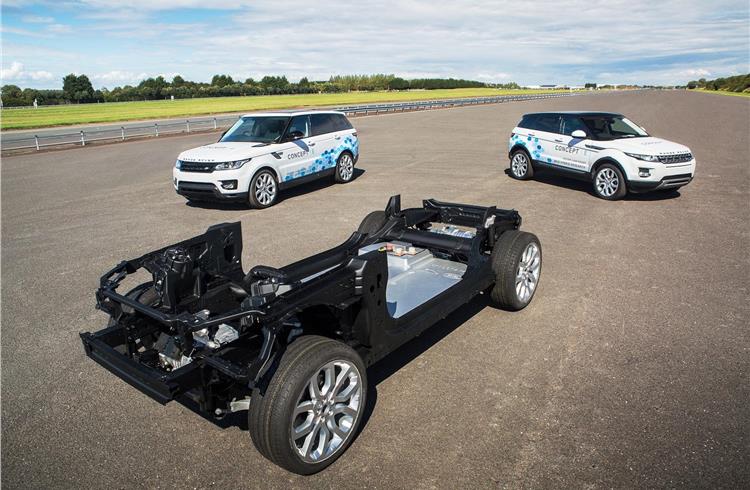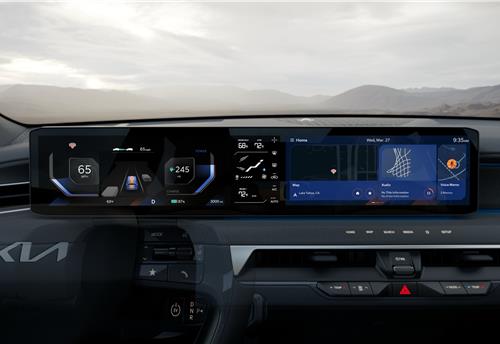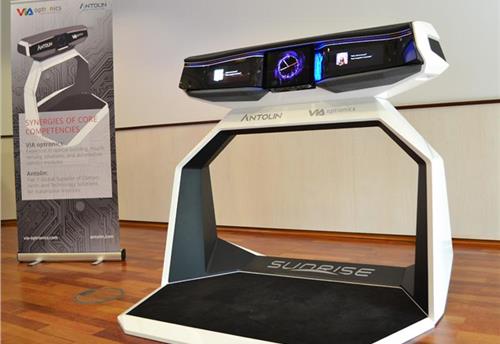Range Rover Evoque concepts preview electric tech
Jaguar Land Rover previews its upcoming electric vehicle technology with hybrid and EV versions of the Range Rover Evoque.
Jaguar Land Rover has revealed three technology demonstrators which give a look at its zero-emission and electric future.
The cars have been in development for the past two years and explore different battery-based options. JLR claims the batteries in question are twice as powerful and capable of producing twice as much torque as any in production today.
It also says they are designed to be integrated with any engine and transmission combination to create a mild hybrid or a plug-in hybrid, or used on their own for a battery-powered electric vehicle.

The first of the cars is called the Concept e MHEV (illustrated above). It is a mild hybrid based on a Range Rover Evoque and pairs a prototype 89bhp diesel engine and a 48V lithium ion battery pack.
The Concept e PHEV is a plug-in hybrid (below). The Range Rover Sport-based model uses a similar set-up to that of the mild hybrid but adds a much larger battery and a 296bhp petrol engine, which is also described as a prototype.


The battery is a 320V lithium ion unit located in the boot of the car, which uses the standard eight-speed automatic gearbox and retains the full-time four-wheel drive system. However, the 150kW electric motor is capable of replacing the starter motor.
The final concept is a bespoke model based on JLR’s new aluminium platform. Its 70kWh lithium ion battery powers an 85kW electric motor on the front axle and a 145kW motor on the rear axle.
A total of 12 partners worked on the Evoque E project. Officials say a key finding was the new modular design for an electric motor, which was designed and developed in-house.
The electric drive module is the core technology of the project. It's light and has around twice the power of today's electric motors. It's suitable for saloons, SUVs and other types of vehicles. It fits between the engine and the transmission and is suitable for transverse or longitudinal applications and any type of transmission.
Many of the technologies developed for the project could have future production applications. The engine in the mild-hybrid Evoque is a three-cylinder diesel research engine developed especially by JLR for this project. The two-speed transmission in the battery research vehicle would be suitable for a Land Rover application as it would aid with low-speed traction.
The brake-by-wire system offers exceptionally strong braking forces (up to 0.5g) and maximises the amount of energy recuperated into the battery pack. This in turn allows for a smaller and therefore lighter and less expensive battery pack to be used as more energy can be recovered.
The torque vectoring also allows for strong independent control of individual wheels; for example, the system can switch between understeer and oversteer in on-limit handling.
Mike Richardson, chief technology specialist of low-carbon vehicles at JLR, said the Evoque E project looked at a whole host of technologies including brake by wire, torque vectoring, battery packaging and drivelines, along with the integration of all these systems in the vehicle. "It looks beyond what we know today," he said.
JLR insists the three cars are merely test prototypes and has not yet revealed any performance details. Any production cars that arise from the testing are unlikely to go on sale before 2020.
‘Warm Air Blanket’
The company has also shown off research that it calls its ‘Warm Air Blanket’. This technology aims to reduce the energy used by a car, by improving the heating and ventilation systems among other things.

JLR is looking at using infra-red reflective glass that reflects the suns rays so less energy is needed to cool the interior. JLR also says it might not even need to heat the whole cabin in the future and is investigating technology that would just heat the occupant through the use of infra-red panels embedded in the sun visors, the tops of the doors and places such as the transmission tunnel.
The company has also developed a 99g/km version of the Evoque called 'Provoque'. It mixes a 2.0-litre Ingenium diesel engine with a 48V mild hybrid system. The engine features an electric supercharger driven by an electric motor that allows high amounts of torque at a low rpm.
JLR's director of research and technology Wolfgang Epple said the firm had been on a multi-crore programme to reduce its CO2 footprint while ensuring its cars retained their luxury, performance, refinement and comfort since 2008.
JLR has cut CO2 emissions by 25% since 2007. Epple said JLR was "researching a range of technologies" to reduce this further, as there was "no single solution".
"We are very serious about battery electric vehicles and plug ins," he said. "The UK can be a world leader in these technologies. It will always remain about customers and driving though, the desire to drive will not disappear."
JLR is also working on developing autonomous vehicles, Epple confirmed.
Epple called on the government to continue to offer subsidies to support the uptake of low-CO2 vehicles and said the current demonisation of diesel was wrong, as the new EU6-compliant engines are very clean and efficient.
He also revealed that the new Ingenium engine family was future-proofed to be up or downscaled depending on demand, and it was adaptable to fit in with any future propulsion tech JLR might develop.
On the future of electrification, Epple said: "Electrification is essential in the premium market for getting below 100g/km. It can't just be about the propulsion system, it must look at parasitic losses [aerodynamics, rolling resistance, energy management, climate control] and weight [architecture, body in white, chassis parts, material application] also.
"We are looking at how to mix carbonfibre with innovative materials and how to manufacturer it at a more affordable price."
Simon Black, senior manager of body engineering at JLR, also revealed a whole range of supporting technologies in the Evoque E project designed at reducing the weight of the vehicle.
'Carbio' is a lightweight material that mixes carbonfibre with cashew nut oil resin and flax to create a material that has the strength of carbonfibre but is cheaper to create (but not manufacture). It also has a lower CO2 footprint to produce. It's 28% lighter than aluminium, 55% lighter than steel and has better sound-proofing qualities than carbonfibre. This in turn further reduces vehicle weight as less sound deadening is needed.
'Varcity' is a lower grade of carbonfibre similar to that used in wind turbines rather than in F1 or aerospace. JLR is looking at how to mix it into bodies, with a target weight reduction of 20% over a pure aluminium structure. It was first explored on the C-X75 concept.
'LANDS' is a lighter sound-deadening material made from recycled plastic and filler made from the sugar refining process. Used in wheelarches, it is as good at deadening sound as existing materials but lighter.
Traditional wiring looms could be replaced by 'printed electronics', which are smaller, lighter and more space efficient. They would improve cabin space and also reduce weight. In a Range Rover, there is 6km of wiring, weighing 94kg.
'Places' looks at a new way of constructing seats without a compromise on comfort. The steel structure is replaced by a lightweight carbonfibre one weighing 30% less and taking up less space, which in turn boosts interior room. The seat cushions and fabrics are also optimised for weight and comfort.
RELATED ARTICLES
Marelli Talbros Chassis Systems wins Rs 1,000 crore business from European OEM
The order, to be executed over an eight-year period, is for the supply suspension arms tailored for both conventional in...
Kia launches customised NBA display themes for North American market
Display Themes is a customised service that supports a personalised vehicle experience, allowing users to customise the ...
Antolin and VIA Optronics unveil versatile vehicle cockpit concept
The Sunrise vehicle concept cockpit, which is engineered for seamless transitions between manual and autonomous driving ...





 10 Sep 2015
10 Sep 2015
 6907 Views
6907 Views





 Autocar Pro News Desk
Autocar Pro News Desk




